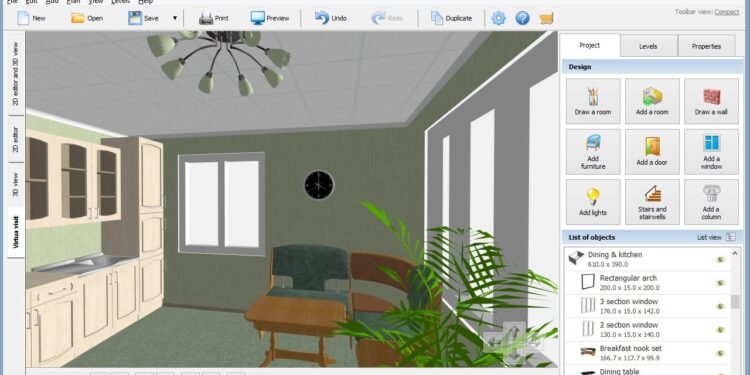Exploring the world of home design and remodeling through digital tools opens up a realm of possibilities. From creating intricate floor plans to visualizing 3D models, these tools have transformed the way projects are approached. Let's delve into the realm of digital innovation in home improvement.
Importance of Digital Tools in Home Design and Remodeling
Digital tools have completely transformed the way home design and remodeling projects are approached. These tools offer a wide range of benefits that enhance accuracy, efficiency, and cost-effectiveness in various aspects of the industry.
Revolutionizing Design and Planning
- Software like AutoCAD and SketchUp allow professionals to create detailed 3D models of spaces, enabling better visualization of design concepts.
- Virtual reality tools like Oculus Rift help clients immerse themselves in virtual walkthroughs of their future homes, making decision-making easier.
Enhancing Efficiency and Accuracy
- Digital tools streamline the design process, reducing the time needed to create and revise plans.
- Tools like room measurement apps ensure precise measurements, minimizing errors during construction.
Cost-Effectiveness and Sustainability
- By using digital tools, homeowners and professionals can experiment with different materials and layouts before committing to costly purchases.
- Energy simulation software helps optimize home designs for energy efficiency, reducing long-term costs and environmental impact.
Features and Functions of Digital Tools
When it comes to digital tools for home design and remodeling, there are several key features that are commonly found across different platforms. These features play a crucial role in helping users create customized designs, visualize spaces, and plan their projects effectively.
Creating Floor Plans
Digital tools offer the functionality to create detailed floor plans, allowing users to map out the layout of their space accurately. Users can input room dimensions, add doors and windows, and even experiment with different layouts to optimize space utilization.
3D Models and Virtual Walkthroughs
One of the standout features of digital tools is the ability to generate 3D models of the designed space. These models provide a realistic representation of the final look, enabling users to visualize the design in a more immersive way.
Virtual walkthroughs further enhance this experience by allowing users to explore the space from different angles, giving a better sense of the flow and functionality of the design.
Customization Options
Digital tools offer a wide range of customization options for personalizing designs to suit individual preferences. From selecting different materials and finishes to experimenting with color schemes and furniture layouts, users have the flexibility to tailor the design according to their taste and style.
This level of customization ensures that the final result reflects the unique vision of the user.
Comparison of Different Digital Tools
When it comes to home design and remodeling, there are several top digital tools available in the market that cater to different needs and preferences. Each tool comes with its own set of strengths and weaknesses, pricing models, subscription plans, and even free alternatives for users to choose from.
Tool 1: SketchUp
SketchUp is a popular choice among designers and architects for its intuitive user interface and powerful 3D modeling capabilities. It offers a free version with limited features, as well as a paid Pro version with more advanced tools. While SketchUp is great for creating detailed 3D models, it may have a steeper learning curve for beginners.
Tool 2: Autodesk Revit
Autodesk Revit is known for its Building Information Modeling (BIM) features, making it a preferred choice for professionals in the architecture and construction industry. It allows users to create detailed designs and collaborate with others in real-time. However, the cost of a Revit subscription can be high, especially for individual users
.
Tool 3: HomeByMe
HomeByMe is a user-friendly tool that is perfect for homeowners looking to design and visualize their spaces. It offers a wide range of furniture and decor options to choose from, making it easy to create realistic 3D renderings. HomeByMe has a free version with limited features, as well as paid subscription plans for more advanced functionality.
Tool 4: Roomstyler
Roomstyler is another popular choice for DIY enthusiasts and interior designers. It offers a simple drag-and-drop interface, allowing users to create room layouts and experiment with different styles. While Roomstyler is free to use, some advanced features may require a paid subscription.
Tool 5: Planner 5D
Planner 5D is a versatile tool that caters to both professionals and beginners. It offers a wide range of customizable templates and design options, making it easy to create floor plans and 3D models. Planner 5D has a free version with limited features, as well as paid subscription plans for additional functionality.
Integration of Digital Tools with Home Improvement Projects
Digital tools play a crucial role in streamlining and enhancing various stages of home improvement projects. From planning to execution, these tools can significantly improve efficiency and collaboration among all parties involved. Here are some tips on effectively integrating digital tools into your home improvement projects:
Planning Phase
- Use digital tools to create virtual design plans and layouts for better visualization of the project.
- Utilize software that allows you to experiment with different design options and materials before making final decisions.
- Collaborate with clients and interior designers by sharing digital mock-ups and receiving instant feedback for adjustments.
Budgeting and Cost Estimation
- Utilize digital tools for accurate cost estimation by inputting materials, labor costs, and other expenses.
- Compare prices and quality of materials online to make informed decisions within your budget.
- Track expenses and budget allocations in real-time to avoid overspending during the project.
Execution and Project Management
- Use project management software to create timelines, assign tasks, and track progress throughout the project.
- Communicate with contractors and subcontractors through digital platforms for updates, deadlines, and changes in plans.
- Monitor the project remotely through digital tools to ensure work is being done as per the plan and quality standards.
Collaboration with Stakeholders
- Share project updates, images, and documents with clients and stakeholders through digital platforms for transparency and feedback.
- Coordinate with interior designers and architects by exchanging design files and ideas digitally for seamless integration of all aspects of the project.
- Facilitate virtual meetings and discussions with all parties involved to ensure everyone is on the same page throughout the project.
Outcome Summary
As we conclude our journey through the realm of digital tools for home design and remodeling, it's evident that these technologies have reshaped the industry. With enhanced accuracy, efficiency, and cost-effectiveness, the future of home renovation looks brighter than ever.
FAQ Summary
What are some benefits of using digital tools for home design and remodeling?
Digital tools offer enhanced accuracy, efficiency, and cost-effectiveness in projects, enabling professionals and DIY enthusiasts to streamline their renovation processes.
Which digital tools are commonly used in the home design industry?
Popular digital tools include software for creating floor plans, 3D models, and virtual walkthroughs, providing users with a comprehensive toolkit for visualizing their projects.
How can digital tools be integrated into home improvement projects effectively?
By utilizing digital tools for planning, budgeting, and execution, individuals can optimize their renovation processes and collaborate seamlessly with clients, contractors, and interior designers.







